英语教学法论文
英语教学的论文
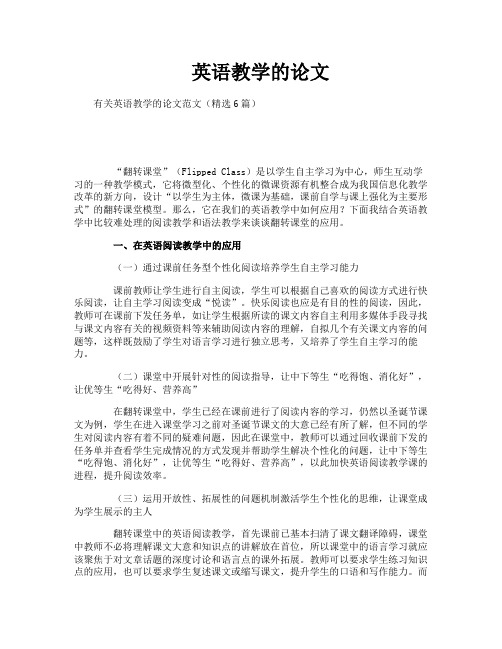
英语教学的论文有关英语教学的论文范文(精选6篇)“翻转课堂”(Flipped Class)是以学生自主学习为中心,师生互动学习的一种教学模式,它将微型化、个性化的微课资源有机整合成为我国信息化教学改革的新方向,设计“以学生为主体,微课为基础,课前自学与课上强化为主要形式”的翻转课堂模型。
那么,它在我们的英语教学中如何应用?下面我结合英语教学中比较难处理的阅读教学和语法教学来谈谈翻转课堂的应用。
一、在英语阅读教学中的应用(一)通过课前任务型个性化阅读培养学生自主学习能力课前教师让学生进行自主阅读,学生可以根据自己喜欢的阅读方式进行快乐阅读,让自主学习阅读变成“悦读”。
快乐阅读也应是有目的性的阅读,因此,教师可在课前下发任务单,如让学生根据所读的课文内容自主利用多媒体手段寻找与课文内容有关的视频资料等来辅助阅读内容的理解,自拟几个有关课文内容的问题等,这样既鼓励了学生对语言学习进行独立思考,又培养了学生自主学习的能力。
(二)课堂中开展针对性的阅读指导,让中下等生“吃得饱、消化好”,让优等生“吃得好、营养高”在翻转课堂中,学生已经在课前进行了阅读内容的学习,仍然以圣诞节课文为例,学生在进入课堂学习之前对圣诞节课文的大意已经有所了解,但不同的学生对阅读内容有着不同的疑难问题,因此在课堂中,教师可以通过回收课前下发的任务单并查看学生完成情况的方式发现并帮助学生解决个性化的问题,让中下等生“吃得饱、消化好”,让优等生“吃得好、营养高”,以此加快英语阅读教学课的进程,提升阅读效率。
(三)运用开放性、拓展性的问题机制激活学生个性化的思维,让课堂成为学生展示的主人翻转课堂中的英语阅读教学,首先课前已基本扫清了课文翻译障碍,课堂中教师不必将理解课文大意和知识点的讲解放在首位,所以课堂中的语言学习就应该聚焦于对文章话题的深度讨论和语言点的课外拓展。
教师可以要求学生练习知识点的应用,也可以要求学生复述课文或缩写课文,提升学生的口语和写作能力。
小学英语教学论文范文(精选)(必备47篇)
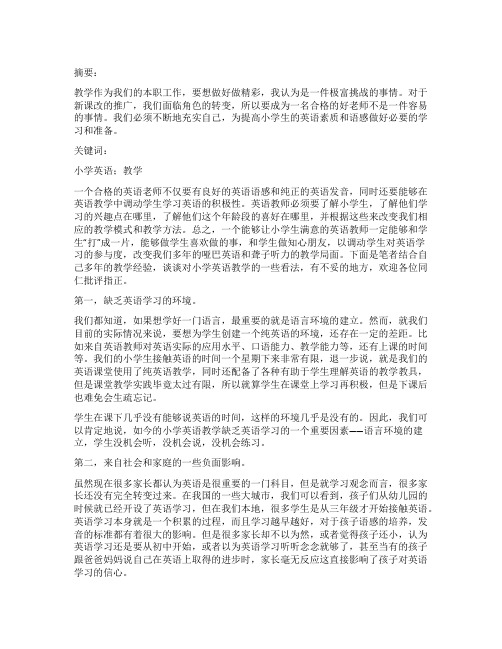
摘要:教学作为我们的本职工作,要想做好做精彩,我认为是一件极富挑战的事情。
对于新课改的推广,我们面临角色的转变,所以要成为一名合格的好老师不是一件容易的事情。
我们必须不断地充实自己,为提高小学生的英语素质和语感做好必要的学习和准备。
关键词:小学英语;教学一个合格的英语老师不仅要有良好的英语语感和纯正的英语发音,同时还要能够在英语教学中调动学生学习英语的积极性。
英语教师必须要了解小学生,了解他们学习的兴趣点在哪里,了解他们这个年龄段的喜好在哪里,并根据这些来改变我们相应的教学模式和教学方法。
总之,一个能够让小学生满意的英语教师一定能够和学生“打”成一片,能够做学生喜欢做的事,和学生做知心朋友,以调动学生对英语学习的参与度,改变我们多年的哑巴英语和聋子听力的教学局面。
下面是笔者结合自己多年的教学经验,谈谈对小学英语教学的一些看法,有不妥的地方,欢迎各位同仁批评指正。
第一,缺乏英语学习的环境。
我们都知道,如果想学好一门语言,最重要的就是语言环境的建立。
然而,就我们目前的实际情况来说,要想为学生创建一个纯英语的环境,还存在一定的差距。
比如来自英语教师对英语实际的应用水平、口语能力、教学能力等,还有上课的时间等。
我们的小学生接触英语的时间一个星期下来非常有限,退一步说,就是我们的英语课堂使用了纯英语教学,同时还配备了各种有助于学生理解英语的教学教具,但是课堂教学实践毕竟太过有限,所以就算学生在课堂上学习再积极,但是下课后也难免会生疏忘记。
学生在课下几乎没有能够说英语的时间,这样的环境几乎是没有的。
因此,我们可以肯定地说,如今的小学英语教学缺乏英语学习的一个重要因素――语言环境的建立,学生没机会听,没机会说,没机会练习。
第二,来自社会和家庭的一些负面影响。
虽然现在很多家长都认为英语是很重要的一门科目,但是就学习观念而言,很多家长还没有完全转变过来。
在我国的一些大城市,我们可以看到,孩子们从幼儿园的时候就已经开设了英语学习,但在我们本地,很多学生是从三年级才开始接触英语。
英语教学方法论文
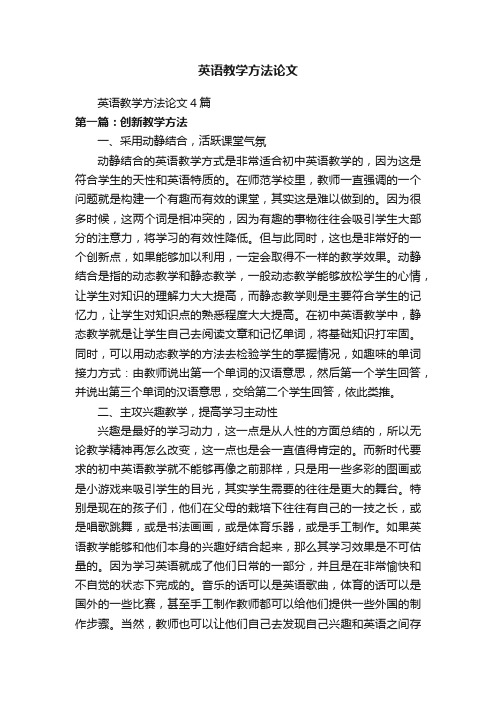
英语教学方法论文英语教学方法论文4篇第一篇:创新教学方法一、采用动静结合,活跃课堂气氛动静结合的英语教学方式是非常适合初中英语教学的,因为这是符合学生的天性和英语特质的。
在师范学校里,教师一直强调的一个问题就是构建一个有趣而有效的课堂,其实这是难以做到的。
因为很多时候,这两个词是相冲突的,因为有趣的事物往往会吸引学生大部分的注意力,将学习的有效性降低。
但与此同时,这也是非常好的一个创新点,如果能够加以利用,一定会取得不一样的教学效果。
动静结合是指的动态教学和静态教学,一般动态教学能够放松学生的心情,让学生对知识的理解力大大提高,而静态教学则是主要符合学生的记忆力,让学生对知识点的熟悉程度大大提高。
在初中英语教学中,静态教学就是让学生自己去阅读文章和记忆单词,将基础知识打牢固。
同时,可以用动态教学的方法去检验学生的掌握情况,如趣味的单词接力方式:由教师说出第一个单词的汉语意思,然后第一个学生回答,并说出第三个单词的汉语意思,交给第二个学生回答,依此类推。
二、主攻兴趣教学,提高学习主动性兴趣是最好的学习动力,这一点是从人性的方面总结的,所以无论教学精神再怎么改变,这一点也是会一直值得肯定的。
而新时代要求的初中英语教学就不能够再像之前那样,只是用一些多彩的图画或是小游戏来吸引学生的目光,其实学生需要的往往是更大的舞台。
特别是现在的孩子们,他们在父母的栽培下往往有自己的一技之长,或是唱歌跳舞,或是书法画画,或是体育乐器,或是手工制作。
如果英语教学能够和他们本身的兴趣好结合起来,那么其学习效果是不可估量的。
因为学习英语就成了他们日常的一部分,并且是在非常愉快和不自觉的状态下完成的。
音乐的话可以是英语歌曲,体育的话可以是国外的一些比赛,甚至手工制作教师都可以给他们提供一些外国的制作步骤。
当然,教师也可以让他们自己去发现自己兴趣和英语之间存在的微妙的关系,并且作为课堂作业向展示。
三、结合时代气息,采用科技教学时代发展迅速,教育也在发生着日新月异的变化,初中英语教学就应该乘着这股东风“扶摇直上”,采用与时代科技相结合的方式去进行创新教学。
小学英语论文小学英语教学论文10篇优秀9篇
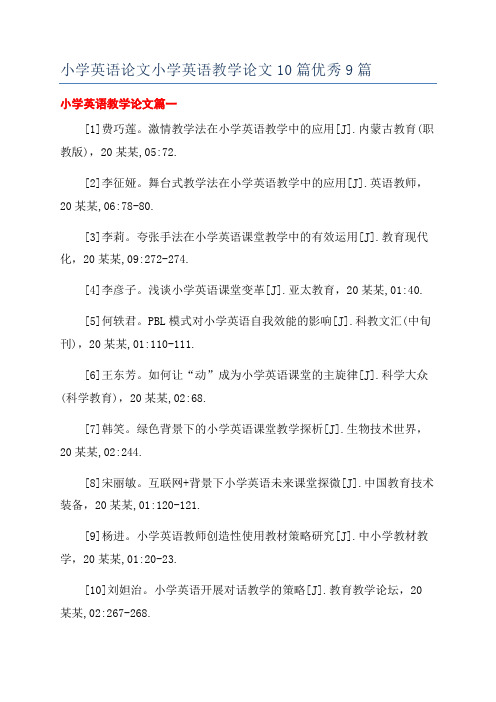
小学英语论文小学英语教学论文10篇优秀9篇小学英语教学论文篇一[1]费巧莲。
激情教学法在小学英语教学中的应用[J].内蒙古教育(职教版),20某某,05:72.[2]李征娅。
舞台式教学法在小学英语教学中的应用[J].英语教师,20某某,06:78-80.[3]李莉。
夸张手法在小学英语课堂教学中的有效运用[J].教育现代化,20某某,09:272-274.[4]李彦子。
浅谈小学英语课堂变革[J].亚太教育,20某某,01:40.[5]何轶君。
PBL模式对小学英语自我效能的影响[J].科教文汇(中旬刊),20某某,01:110-111.[6]王东芳。
如何让“动”成为小学英语课堂的主旋律[J].科学大众(科学教育),20某某,02:68.[7]韩笑。
绿色背景下的小学英语课堂教学探析[J].生物技术世界,20某某,02:244.[8]宋丽敏。
互联网+背景下小学英语未来课堂探微[J].中国教育技术装备,20某某,01:120-121.[9]杨进。
小学英语教师创造性使用教材策略研究[J].中小学教材教学,20某某,01:20-23.[10]刘妲治。
小学英语开展对话教学的策略[J].教育教学论坛,20某某,02:267-268.[11]路亚涵。
浅谈小学英语教育中的创造教育[J].教育现代化,20某某,01:228-229.[12]完玛草。
自然拼读法在小学英语教学中的应用[J].西部素质教育,20某某,04:179.[13]王秀国。
小学英语课外阅读习惯的养成分析[J].西部素质教育,20某某,02:166.[14]王思佳。
思维导图在小学英语词汇教学中的应用[J].读与写(教育教学刊),20某某,01:101+112.[15]刘思瑶。
故事教学法在小学英语教学中的应用[J].黑龙江教育(理论与实践),20某某,03:56-57.[16]王凤英。
浅谈小学英语两级分化的成因以及改进方法[J].才智,20某某,04:193.[17]沈丽萍。
高中英语教学论文8篇
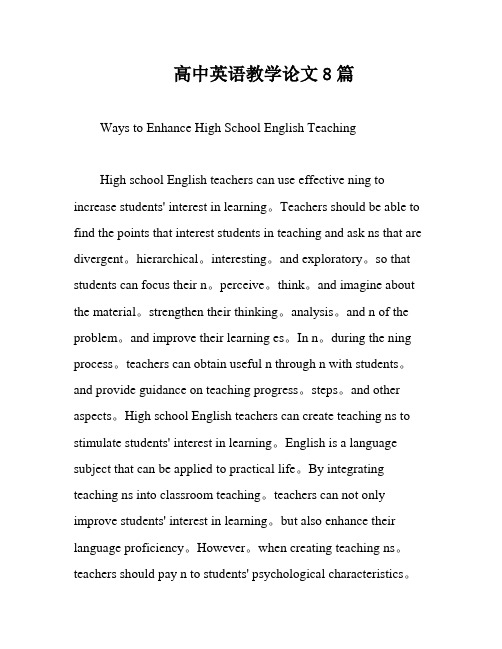
高中英语教学论文8篇Ways to Enhance High School English TeachingHigh school English teachers can use effective ning to increase students' interest in learning。
Teachers should be able to find the points that interest students in teaching and ask ns that are divergent。
hierarchical。
interesting。
and exploratory。
so that students can focus their n。
perceive。
think。
and imagine about the material。
strengthen their thinking。
analysis。
and n of the problem。
and improve their learning es。
In n。
during the ning process。
teachers can obtain useful n through n with students。
and provide guidance on teaching progress。
steps。
and other aspects。
High school English teachers can create teaching ns to stimulate students' interest in learning。
English is a language subject that can be applied to practical life。
By integrating teaching ns into classroom teaching。
大学英语教学论文(9篇)_英语论文

大学英语教学论文(9篇)_英语论文第一篇:独立学院大学英语教学ESP理论应用一、引言独立学院以培养符合社会和市场需求的应用型人才为目标,在我国高等教育大众化发展现阶段,独立学院面临着空前挑战和激烈竞争。
大学英语是规模最大的基础课程,近年来各独立学院纷纷进行大学英语改革,如分级教学、模块教学、翻转课堂等。
改革在一定程度上提高了学生的英语水平,但目前独立学院大学英语以一般用途英语(EnglishforGeneralPur-pose)为主,虽然强调提高学生听、说、读、写、译技能,但实际上主要目标是提高学生的应试能力,尤其是通过全国大学英语四六级考试的能力。
因此,不足以满足学生毕业后对英语的日常和工作需求,未能很好地实现独立学院培养应用型人才这一目标。
专门用途英语,即ESP(EnglishforSpecificPurposes),是近年来外语教育界研究的热点之一,尤其受到独立学院英语教师们的关注。
在EGP的基础上,ESP不但适合我国现阶段英语教学发展要求,而且将英语教学和学生将来职业发展联系起来,针对性强,符合独立学院应用型人才培养目标。
二、ESP简介ESP产生于二战后,许多国家正重振经济、发展科技、加强国际间交流。
英语已被认为是科技和商贸领域里的国际语言,因此,人们学习英语的目的十分明确,即掌握英语为自己所从事的专业服务。
随着社会发展,ESP成为社会语言学关于变体理论、功能分类理论、语域理论在外语教学中的具体运用。
在大学英语教学中,和EGP不同,ESP是为了满足学习者特定的学习要求而与某种特定职业或学科相关的英语学习。
除了基本的语言技能之外,在内容方面与特定职业或专业相关,更具有专业内涵性和实际应用性,如旅游英语、商务英语、法律英语、计算机英语等。
因此,EGP教授的是英语语言的普遍现象,而ESP是以EGP为基础,在EGP 的基础上不同专业的变体,是EGP发展的高级阶段。
三、ESP理论在独立学院中的应用分析(一)学生分析因定位和自身特点,独立学院生源质量与普通高校相比存在一定的差距。
浅谈英语教学方法论文
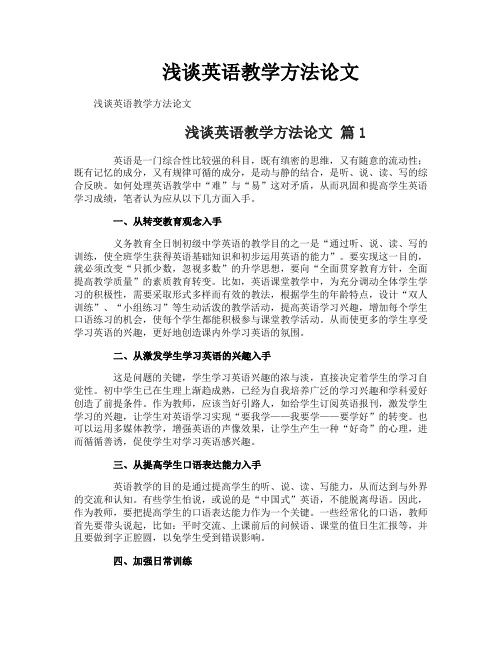
浅谈英语教学方法论文浅谈英语教学方法论文浅谈英语教学方法论文篇1英语是一门综合性比较强的科目,既有缜密的思维,又有随意的流动性;既有记忆的成分,又有规律可循的成分,是动与静的结合,是听、说、读、写的综合反映。
如何处理英语教学中“难”与“易”这对矛盾,从而巩固和提高学生英语学习成绩,笔者认为应从以下几方面入手。
一、从转变教育观念入手义务教育全日制初级中学英语的教学目的之一是“通过听、说、读、写的训练,使全班学生获得英语基础知识和初步运用英语的能力”。
要实现这一目的,就必须改变“只抓少数,忽视多数”的升学思想,要向“全面贯穿教育方针,全面提高教学质量”的素质教育转变。
比如,英语课堂教学中,为充分调动全体学生学习的积极性,需要采取形式多样而有效的教法,根据学生的年龄特点,设计“双人训练”、“小组练习”等生动活泼的教学活动,提高英语学习兴趣,增加每个学生口语练习的机会,使每个学生都能积极参与课堂教学活动。
从而使更多的学生享受学习英语的兴趣,更好地创造课内外学习英语的氛围。
二、从激发学生学习英语的兴趣入手这是问题的关键,学生学习英语兴趣的浓与淡,直接决定着学生的学习自觉性。
初中学生已在生理上渐趋成熟,已经为自我培养广泛的学习兴趣和学科爱好创造了前提条件。
作为教师,应该当好引路人,如给学生订阅英语报刊,激发学生学习的兴趣,让学生对英语学习实现“要我学——我要学——要学好”的转变。
也可以运用多媒体教学,增强英语的声像效果,让学生产生一种“好奇”的心理,进而循循善诱,促使学生对学习英语感兴趣。
三、从提高学生口语表达能力入手英语教学的目的是通过提高学生的听、说、读、写能力,从而达到与外界的交流和认知。
有些学生怕说,或说的是“中国式”英语,不能脱离母语。
因此,作为教师,要把提高学生的口语表达能力作为一个关键。
一些经常化的口语,教师首先要带头说起,比如:平时交流、上课前后的问候语、课堂的值日生汇报等,并且要做到字正腔圆,以免学生受到错误影响。
初中英语教学优秀论文3篇

初中英语教学优秀论文3篇
论文1:提高初中英语教学质量的有效策略
这篇论文探讨了提高初中英语教学质量的有效策略。
作者首先分析了初中英语教学存在的问题,如学生研究动力不足、教材内容单一等。
接着,作者提出了一些行之有效的策略,包括鼓励互动式研究、提供个性化辅导等。
最后,作者通过实践案例证明了这些策略的有效性。
论文2:提高初中英语口语能力的教学方法研究
本文旨在研究提高初中学生英语口语能力的教学方法。
作者通过对现有教学方法的分析和评估,提出了一种以情景教学为基础的方法。
该方法通过创造真实的语境,促使学生主动参与口语表达。
实证研究表明,该方法可以有效提高学生的口语能力。
论文3:初中英语课堂互动教学的实施策略
这篇论文介绍了初中英语课堂互动教学的实施策略。
作者提出了一套可行的策略,包括采用小组活动、引入多媒体资源等。
通过实际教学案例的分析,作者证明了这些策略能够激发学生的研究兴趣,提高课堂互动效果。
以上是三篇关于初中英语教学的优秀论文的简要介绍,希望对您有所帮助。
如需详细内容,请查阅相关文献。
- 1、下载文档前请自行甄别文档内容的完整性,平台不提供额外的编辑、内容补充、找答案等附加服务。
- 2、"仅部分预览"的文档,不可在线预览部分如存在完整性等问题,可反馈申请退款(可完整预览的文档不适用该条件!)。
- 3、如文档侵犯您的权益,请联系客服反馈,我们会尽快为您处理(人工客服工作时间:9:00-18:30)。
Brief analysis on English Teaching for Kids1.IntroductionAs an important part of pedagogy, the research on teaching methods has never stopped. Changes in language teaching methods have reflected changes in theories of the nature of language and of language learning. Here in this thesis the author introduces several teaching methods and, with the help of the personal working experience in a kids’ English teaching institution----LeXue, analyses the application of these methods and their effectiveness.2.The Communicative ApproachThe Communicative Approach is an approach to foreign or second language teaching which empathizes that the goal of language learning is communicative competence. Teaching materials used with the Communicative approach often teach the language needed to express and understand different kinds of function.2.1 Features of the Communicative ApproachFive points to characterize the Communicative Approach:①Emphasis on learning to communicate in the target language②The introduction of authentic texts into learning situations③Focus not only on language but also on the learning process itself④making use of learner’s own personal experiences⑤Creating real communication situations in the classroom; linking classroomlanguage learning with language activation outside the classroom The most obvious characteristics of the Communicative Approach is that almost everything that is done with a communicative intent. The teacher is concernedwith the learners themselves, their feelings and ideas. The classroom activities are learner-centered because learning is more effective when the learners are actively involved in the learning process.2.2 The application of Communicative Approach and its EffectAs the theory suggests, during the teaching activities, the role of the teacher should be a facilitator of students’ learning and a manager of classroom activities. And the aim of the teaching should be giving the students the ability to use English for communication. At LeXue, rule has been set that each lesson should be taught by tow teachers, one foreign and one Chinese with the foreign teacher being the superior one to teach the little kids, thus setting up a kind of atmosphere for the kid to speak English. It normalizes the speaking, which allows the students to communicate with foreigner in English just like they do with others in native language. For a lack of language environment, lots of kids can not speak English well simply because they are afraid to do so, that they are not used to this kind of communication. When they go to school and have formal education on English, what they will mainly deal with is the grammar and written materials. Both the educational system and the students forget that the purpose of a language is to communicate. Now, more and more institutions like LeXue are focusing on improving the kids’capability to speak English, and it is really a trend worthy of praise.3.SuggestopediaA teaching method developed by the Bulgarian psychotherapist Georgi Lozanov. It strongly depends on the trust that students develop towards the method by simply believing that it works. Some of the key elements of Suggestopedia include a rich sensory learning environment (pictures, colour, music, etc.), a positive expectation of success and the use of a varied range of methods: dramatised texts, music, active participation in songs and games, etc.3.1 The Four Main Stages①PresentationA preparatory stage in which students are helped to relax and move into a positive frame of mind, with the feeling that the learning is going to be easy and fun.②First Concert - "Active Concert"This involves the active presentation of the material to be learnt. For example, in a foreign language course there might be the dramatic reading of a piece of text, accompanied by classical music.③Second Concert - "Passive Review"The students are now invited to relax and listen to some Baroque music, with the text being read very quietly in the background. The music is specially selected to bring the students into the optimum mental state for the effortless acquisition of the material.④PracticeThe use of a range of games, puzzles, etc. to review and consolidate the learning.3.2 The Practical ApplicationApparently the core value of this method is using the environmental or mental factors to improve the learning. Kids are tend to become interested in the things with bright color and media materials, so at LeXue, lots of things were applied, ranging from the classroom decorations to the media stuff application like playing music, showing movies and so on. Besides, author also realized that there was a strong Pygmalion effect going on between the students and the teachers, which means the more the teacher shows the one student the expectation the better the student performs. What’s more, to let the students become fond of the teacher is also an important part for the little kids to learn English well. Kids are not like adults, if they simply don’t like the person standing in front of them, then no matter how well that person teaches, they just won’t listen.4. Total Physical ResponseTotal physical response (TPR) is a language-teaching method developed by James Asher, a professor emeritus of psychology at San José State University. It is based on the coordination of language and physical movement. In TPR, instructors give commands to students in the target language, and students respond withwhole-body actions.The method is an example of the comprehension approach to language teaching. Listening serves two purposes; it is both a means of understanding messages in the language being learned, and a means of learning the structure of the language itself.4.1 Principles of Total Physical Response①In total physical response, students are not forced to speak. Instead, teachers wait until students acquire enough language through listening that they start to speak spontaneously.②While the majority of class time in total physical response is spent on listening comprehension, the ultimate goal of the method is to develop oral fluency. Asher sees developing listening comprehension skills as the most efficient way of developing spoken language skills.③Grammar is not taught explicitly, but is induced from the language input.4.2 The Application and the InfluencesTotal physical response lessons typically use a wide variety of realia, posters, and props. Teaching materials are not compulsory, and for the very first lessons they may not be used. As students progress in ability the teacher may begin to use objects found in the classroom such as furniture or books, and later may use word charts,pictures, and realia. At LeXue, there are a number of specialized TPR teaching products available, including and an interactive CD-ROM for students to practice with privately. And the teachers will play some games with the kids such as Point and Take. It is fun and easy. Students will enjoy getting up out of their chairs and moving around, especially when it is hard for a teacher to get the kids sit still on chair. It is good for kinesthetic learners who need to be active in the class. It is a good tool for building vocabulary. It is memorable. Actions help strengthen the connections in the brain.5. ConclusionThe above methods all express different points of view of different scholars, each of them respectively provides us a perspective of kids’ English teaching methods. The first theory emphasizes the purpose of English teaching, the second heightens the importance of the unconscious factors in English teaching. The last one places the importance of the physical activities in language teaching. The methods all have instructive value on English teaching. We should really pay attention to their actual application.References[1] 郭羡.少儿英语教学法浅析[J].科技信息2005,(10)[2] 张秀明. “暗示法”在外语教学中的应用[J].福建外语,1997,(2)[3] 何自然.语用学与英语学习[M].上海:上海外国语教育出版社.[4] 王电建,赖红玲.基础英语教学中童谣、歌曲的选择及具体教法[J].英语教学研究2011,26(3)[5]袁笠菱,多媒体课件在英语教学中效益问题初探[J].北京第二外国语学院学报,2005,(06):45-47[6]维基百科,Total physical response[EB/OL]. /wiki/Total_physical_response#Teaching_materials,2013.11.7。
